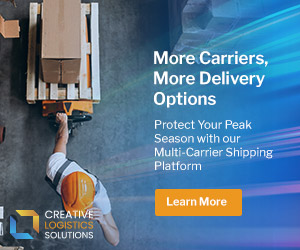Shipping Automation: How It Works + Benefits
Robotic arms grasp packages, autonomous vehicles navigate between shelves, and drones swoop down to leave orders on doorsteps. Sounds like something straight out of a sci-fi movie, right?

Although a fully-automated order fulfillment process might still be the future, automation is one of the biggest logistics trends of 2023. Read on to learn how you can tap into the power of shipping automation and unlock the door to rapid organizational growth.
What is shipping automation?
Shipping automation is the use of technology to manage the shipping and logistics process, including tasks like inventory management, order fulfillment, label generation, and package tracking. Automation reduces the potential for human error and makes shipping workflows more efficient.
As your company scales, you’re sure to run into shipping challenges: increasing returns requests, less-than-accurate inventory counts, international shipping headaches, and more. Automation helps you navigate these challenges. Although some types of automation come with a steep upfront cost, you’ll save money in the long run as you devote more time to revenue-generating activities.
Successful organizations understand the importance of shipping automation. In one survey, 74% of respondents say they’re actively increasing their investment in supply chain technology. Another discovered that 80% of organizations plan to invest in new technology to stay competitive. And 96% of supply chain leaders believe that innovation is extremely important to growth. So how will automation help your business? We’ll explore a few ways below.
How automated shipping speeds up growth
Automated shipping allows you to repurpose resources, spend less money, and optimize your supply chain. Depending on your business’s situation, you can go all-out or start with simple changes. Some of the top shipping automations on organizations’ to-do lists include reporting, conveyance, labeling, packaging, and picking. The opportunities are nearly endless, but here are just a few:
Order picking and packing
Non-automated order picking involves a lot of walking time; it’s estimated that warehouse workers have to walk between 5 and 10 miles a day. Similarly, packing can be time-consuming (and is also an error-prone process).
The solution? Automate sorting, picking, and packing processes. A good place to start is with a warehouse management system (WMS), which helps with warehouse layout optimization, picking and packing efficiency, and much more.
To take warehouse automation a step further, consider investing in robotics like automated guided vehicles (AGVs), autonomous mobile robots (AMRs), or automated storage and retrieval systems (AS/RS). Robotics are on the rise—it’s estimated that by 2025, over 4 million commercial robots will be installed in over 50,000 warehouses.
Inventory management
Managing inventory manually requires in-depth knowledge of spreadsheets, lots of time, and a keen eye for detail—and it’s still easy to make mistakes. You can automate the process using an inventory management system that tracks stock levels, alerts you when stock is low, and automatically reorders inventory.
Automated shipping labels
Once orders are picked and packed, it’s time to ship them. Easier said than done, right? With so many carriers out there, each with its own pricing model and SLAs, it can be tricky to know if you’re getting the best deal on shipping.
Software like InfoShip makes it easy to automatically generate shipping labels. Automatic shipping systems let you set up predefined rules (or conditions) to keep your shipments consistent and accurate. You can choose shipping methods based on certain criteria, such as package dimensions and weight. By automatically generating labels in bulk, you’ll minimize manual data entry, reduce errors, and save lots of time.
Shipment tracking
Consumers value the ability to track their orders; over 90% want the ability to track their packages, with 41% wanting real-time updates and 50% only looking for a general idea of where their order is. Unfortunately, a third of consumers were unable to track their most recent delivery, according to a recent report. With the right shipping technology, you can automatically provide real-time shipment updates so customers know exactly where their packages are and when they’ll arrive. You’ll boost customer satisfaction, save time for your customer service team, and—perhaps most importantly—establish a reputation for transparency.
Shipping documents
Unless you’re a human filing cabinet, dealing with shipping documents probably isn’t your favorite thing to do. Depending on what you’re sending, there can be a lot of documentation involved. Add international shipping into the mix, and you’re in for a lot of paperwork.
You can save hours of tedious work by automating the creation of essential shipping documents like invoices, packing slips, bills of lading, customs declarations, and more. Shipping solutions automatically gather the correct information and put it into the right format, ensuring that documents are compliant with regulations. Not only will this save time, but it will also minimize customs delays or other issues caused by incorrect documentation.
Insurance
Customers want to keep their orders safe—after all, nobody plans on having their purchase stolen from the doorstep or delivered to the wrong address. Shipping insurance protects packages from loss, theft, or damage.
You can build customer confidence by automating the addition of shipping insurance. Simply offer the option to choose insurance at checkout. Once the customer decides to add insurance, their package is automatically covered. You might be surprised by how many customers go this route: one survey discovered that 65% of people are interested in the option to add shipping insurance during checkout.
If you’d rather pay for shipping insurance yourself, you can always set a rule in your shipping software that automatically purchases insurance for orders that meet a certain set of criteria.
Customer service
Despite all your precautions, shipments will sometimes go wrong. But even the worst shipping mishaps can be smoothed over with top-notch customer service.
You can use a variety of automation methods to improve your customer service. Increasingly, companies are using chatbots to offer 24/7 support. By directing customers to resources that answer basic questions, chatbots free up customer service representatives to handle more complex inquiries.
Other automations that enhance the customer experience include order status updates, personalized recommendations, and self-service customer portals.
What are the benefits of automated shipping?

Seventy-nine percent of organizations with superior supply chain capabilities experience significantly above-average revenue growth. When you switch from manual to automated workflows, you’ll quickly start to reap the benefits. As you save time and money, your business will perform better, grow more quickly, and build better relationships with customers.
Saves time
Arguably the most significant benefit of shipping automation is that it saves time.
By automating shipping tasks like picking, packing, and label generation, you’ll free up employees to focus on more specialized, value-adding tasks. Because human labor costs more in the long run than using technology, you should make the most of your workforce.
Leaving tedious, time-consuming activities to technology also frees up warehouse managers to focus on strategy. They’ll be able to allocate less time to overseeing processes and more time analyzing performance data, identifying trends, and making decisions.
Saves money
Saving time usually has a direct correlation to saving money. Because technology is less expensive in the long run than human labor, when you invest in automation, you can employ a leaner crew. Then that crew can devote their time and attention to revenue-generating activities.
Of course, automation doesn’t need to entirely replace your human workforce. While that might be the most cost-effective option, it’s not necessarily the most effective one. The majority of organizations (73%) believe that the best operational models balance human labor and automation. As a Deloitte article points out, “When talent feels like they are central to the organization’s mission and have a line of sight into their career, automation turns into an asset as opposed to an inhibitor.”
Other money-saving automation strategies include optimizing packaging to reduce order weight (and shipping costs), letting software shop for the best shipping prices, and improving order accuracy to reduce returns.
Increases your capacity to grow
Finding the right people to help run your business is no walk in the park (60% of businesses cite recruitment and productivity as a top challenge). But hiring more employees isn’t necessarily the best way to grow your business. Instead, you can invest in shipping automation technology and infrastructure.
As your order volume scales, small inefficiencies in the shipping process can create friction that slows you down, potentially leading to dissatisfied customers. Automation eliminates those friction points, allowing you to fulfill more orders as your business expands. You can keep up with your growing business instead of slowing down.
Helps you track your inventory accurately and efficiently
Inventory management is a crucial part of running an ecommerce business. Order too much, and you might as well throw money away. Order too little, and you miss out on opportunities to make sales. Shipping automation tools can help track inventory data accurately and in real time, even across multiple locations, reducing stockouts and overstocking.
Improves shipping times
In a customer’s eyes, speed is everything. They want their packages fast, and they don’t want to pay a pretty penny for it. In fact, extra costs (shipping and other fees) are the second most common reason people abandon their carts. Software like InfoShip finds the best shipping times for the best price, so you can offer fast shipping to customers without passing an additional cost to them.
Consolidates data and provides insight into demand
Data is most powerful when it lives in one place. With automation, all your shipping data is funneled into a single system. With this increased visibility, you’re better equipped to forecast demand and make decisions.
Creates a better customer experience
Simply put, better order fulfillment equals a better customer experience. And experience is crucial; when consumers lose trust in a business, 71% of them are unlikely to buy again. Automation helps reduce simple mistakes that can have big consequences. The results? A buying experience that keeps customers coming back.
Get started with shipping automation
InfoShip automates core shipping functions to help businesses streamline their operations. With InfoShip, you can easily adopt a multi-carrier shipping strategy, shop for the best rates and times, verify addresses, track shipments, and more.





